|
   |
|
Page 5 |
Newsletter 135 Winter 2021 © Hampshire Mills Group |
|
Pump House, Redbridge Lane, Old Basing
Debbie Reavell,
Basingstoke Heritage Society
Photos by Bob Moore in 2021 and John Oliver in 1972
|
|
Basingstoke
Heritage Society
www.bas-herit-soc.org
was founded in 1989 and is concerned with the
unparished areas of Basingstoke. Normally a
structure within Old Basing Parish Council area
would not be something we would comment on, but this
is very interesting. In May 2021 an investigator of
things curious put on to Facebook’s Basingstoke
History page a link to a YouTube film of a structure
he had ‘discovered’ off Redbridge Lane. His name is
Bob Moore and this is the link to his film:
https://youtu.be/2ZQPyPOH4oo
|
|

|
We became
curious about this structure and discovered that it
was on the Historic Environment Record (HER) record
but with scant description. It also appears to be
marked on the 1759 Taylor map of Hampshire and in
1791, the Milne map, marked as ‘Engine’. (See
below.)
|
|
It had been
noted by an Industrial Archaeology group at
Southampton University in the 1970s and I was able
to obtain a copy via Amazon of their report. (See
editor’s note below.) This noted that occasional
use of the pump supplied water to ‘estate’ cottages.
These may mean Swing Bridge cottages nearby, which
seem to have had access to a hand-pump near the pump
house. There was a road or track called The Pipes
from Redbridge Lane to Hackwood Farm Cottages within
living memory.
|
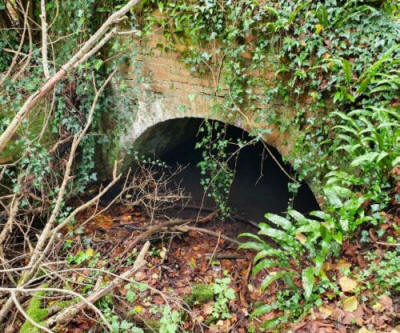
|
|
Hackwood
House has a long history beginning with the
enclosure of the land in the 13th century as a
hunting area. There was a house there in 1628, but
not in the precise location as today – the present
house was begun in 1683. By the time William, 2nd
Baron Bolton, inherited in 1807 he clearly felt it
needed some improvement and Lewis Wyatt was engaged
to do the work, which included improving the water
supply. (While working at Hackwood, Lewis Wyatt
designed Basingstoke’s new town hall, which is now
The Willis Museum in Market Place, and the Bolton
Arch at the London Road entrance to Crabtree.) The
pump is on private land owned by a Trustee company
of family descendants of Viscount Camrose.
Mills and
Millers of North Hampshire Vol 3 North and East had
a helpful entry about the pump, including a note by
Brian Spicer who had been agent for the Hon Mrs
Julian Berry. This was in 2003 and the dense
vegetation was commented on then. Brian is well
known to our Society and has given many talks on the
Hackwood Estate. The pump house entry is shared
with a piece about Basing Upper Mill, which later
became a farm and has been demolished. (Editor:
Brian’s note says that the pipes ran from Home Farm
to a reservoir on Spring Wood.)
We wrote
about the Pump House in our July 2021 newsletter,
which prompted interest from a member, who is also a
member of Hampshire Mills Group. Best of all was
that another member produced a set of slides taken
in 1972 by her husband, the late John Oliver.
|
|
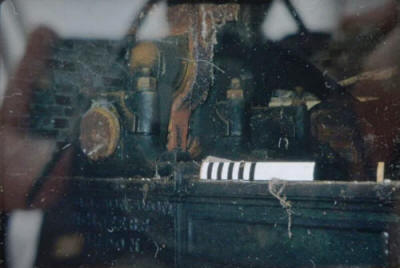
|
These were a
series done for a publication called Hampshire
Treasures – they required scanning and enlarging to
show what the eye could not see – the words ‘Simpson
& Son , Engineers, London’ are just readable on the
lower left of this photo. Below is a photo of the
axle and arms of the water wheel.
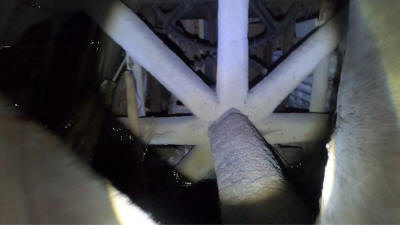
|
|
Research in
the Hampshire Record Office was revealing. Because
of ‘you know what’, we couldn’t or were reluctant to
go and research in person, but the catalogue showed
that there were relevant documents. These
eventually arrived, and are summarised below:
 |
A
Statement of Account headed Chelsea Water Works,
dated 1794 (11M49/468), together with a note to
a Mr Dunn to begin ‘cutting the wood’. From
other parts of this letter, we understood this
to be for oak ‘starts’ and elm ‘floats’. £224
had already been paid and there was a balance
due of £212 13s 6d. A comparison site suggests
that this would be around £26,000 today.
|
 |
Then in
1820 a letter from Thomas Simpson referring to
two estimates for Water Wheels and Engines and
pushing hard for the business – iron pipes had
already been provided. (H/C/3/2
11M49/E/B1/15/2). |
 |
Another
document was a letter from architect Lewis Wyatt
(1777-1853) dated November 1820 sent to the Rev
J Orde, brother-in-law to the then Duke, and it
seems, acting for him while the Duke vacated the
house for the substantial work. The Reverend
Orde was vicar at nearby Winslade. |
What next?
It is possible that the ironwork and the early use
of iron pipes makes the structure worthy of
Statutory Listing and we expect an application to be
done by the Conservation Officer at Basingstoke &
Deane Borough Council in due course.
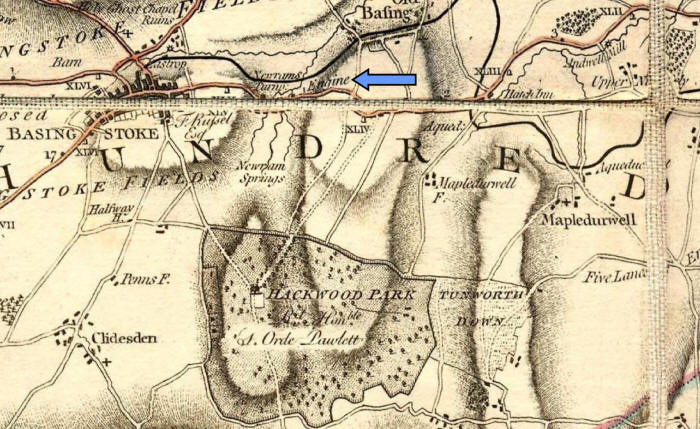
Milne’s
Hampshire Map of 1791. Is this the Engine pumping
water to Hackwood?
Editor’s note:
The
report in Industrial Archaeology, A Guide published
in 1975 by Southampton University Industrial
Archaeology Group (SUIAG), edited by Monica Ellis,
reads:
On the
opposite side of the A30 from Hackwood House is an
iron waterwheel, about 6ft in width, breastshot,
which used to drive pumps to supply water to the
house. The machinery is in a square brick building
with a slate roof and is still used occasionally to
supply water to some nearby estate cottages.
(Text by
permission of Hampshire Industrial Archaeology
Group, successor to SUIAG.)
There are
several similar (but probably newer) examples of
water wheels in Hampshire that were used to pump
water to country houses. HMG looked at several of
these, of which the two shown in my pictures below
at Brambridge House (left) in 1993 and Worthy Park
(right) in 2005, both on the River Itchen, are
typical examples.
|
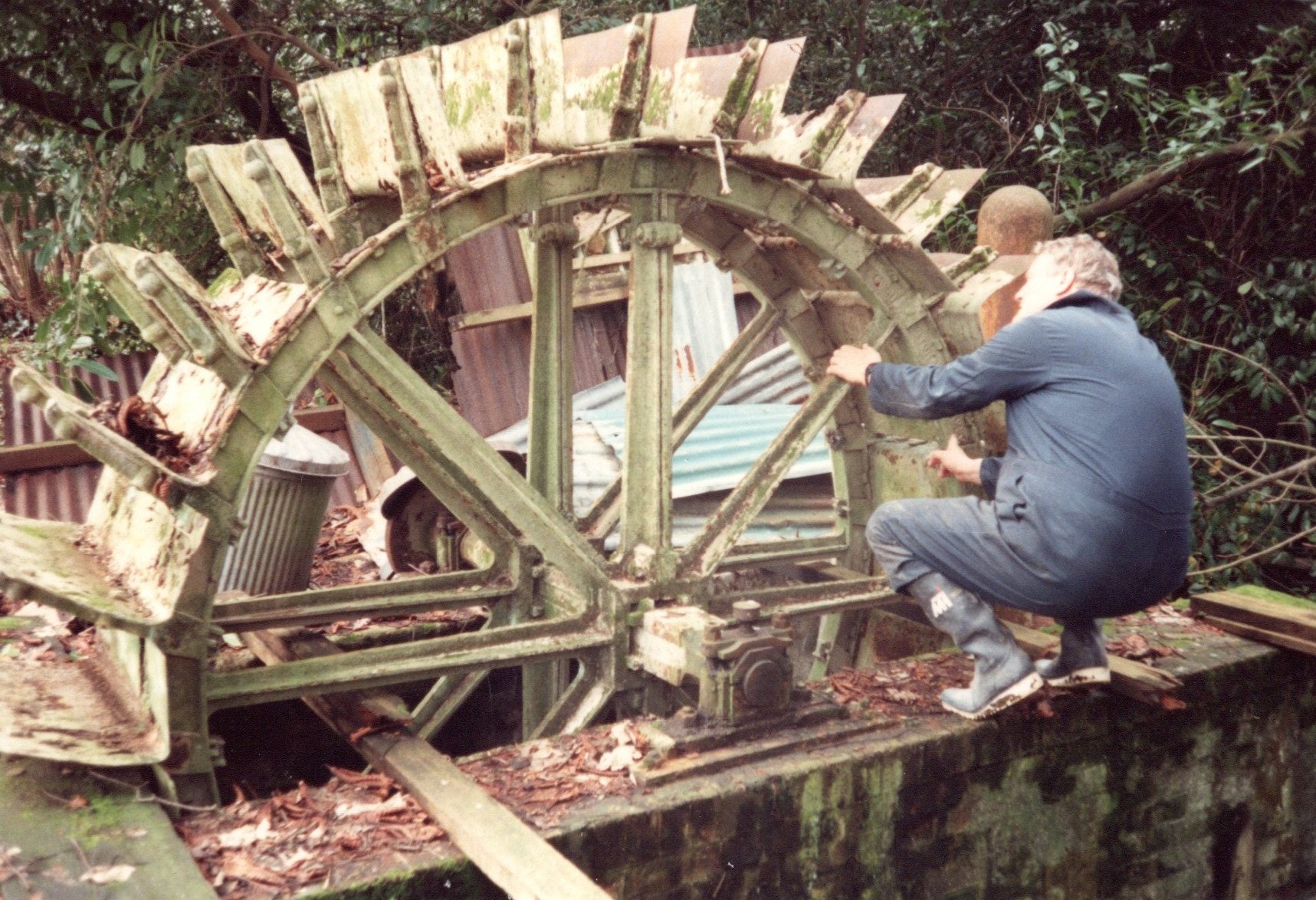 |
 |
|
|
